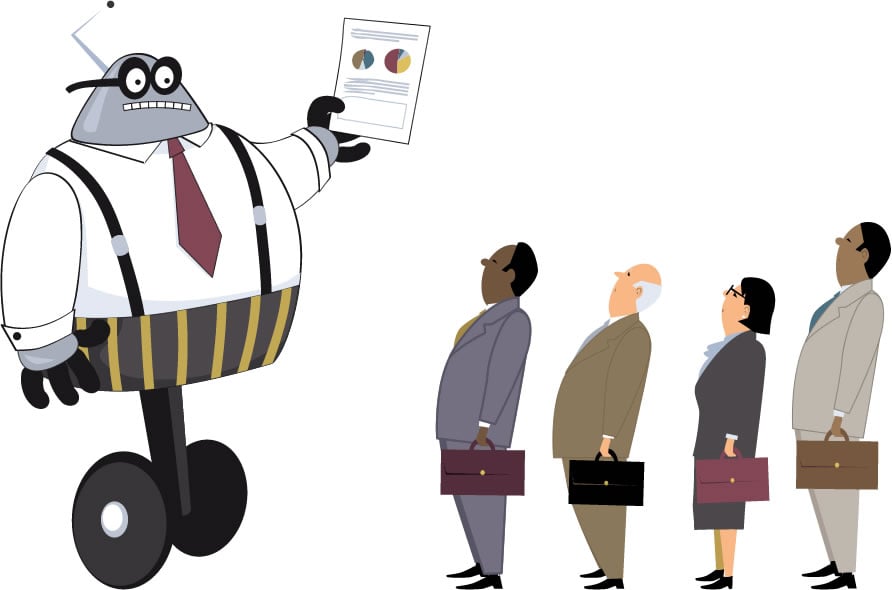
In theory, Artificial Intelligence (A.I.) gives companies the ability to pass human recruiting tasks on to automated tools. Not only does this delegate the prescreening process to a robot, it can also prevent would-be candidates from even becoming applicants. This would effectively reduce the need for “turndown” or rejection letters, at least within the initial phase of the recruiting process.
In an effort to decrease the high volume some recruiting teams deal with, A.I. tools handle prescreening questions, skills assessments, and even administer challenges or tests that a potential applicant would need to pass before being moved on to the next step in the process. The next step being the part where they deal with an actual human.
One of the main ideas behind utilizing A.I. in recruiting is to avoid the time a person has to spend reviewing candidates who don’t meet the minimum technical skills to do the work. An A.I. tool will handle that based upon what it knows about what the requirements of the role (assuming that sufficient information has been provided about the job).
As streamlined as this technology can make recruiting processes, it fails to encompass the very human factor of hiring in its entirety. One of the most critical components of the hiring process is assessing candidates based upon their soft skills. Things like broad perspectives, a collaborative mindset, social aptitude, energy and humility, are all highly valued by senior leadership, the majority of whom prefer to hire for personality over skill. A.I. also cannot assess past behavior and performance to utilize as an indicator of future behavior, as is done in behavioral based interviewing.
The costs associated with A.I. recruiting tools and its relevance and worth related to most positions just doesn’t outweigh its advantages for many employers. Outside of organizations hiring a large volume of highly technical roles, many businesses are simply not in a position to justify the cost or in a position to lose great candidates. A.I. also doesn’t support the human element of recruiting for low or unskilled positions, in which case the focus is generally on trainability and personality traits.
While hiring the right people in the first place partially impacts retention, it’s more importantly based on how an employee is treated after they’re already hired. The top three reasons people leave their jobs are because of low salary, being over worked, and feeling like their employer doesn’t care about them. None of these concerns, for example, talking through salary requirements, can be properly addressed or vetted through the use of A.I. prior to someone coming on board.
A.I. recruiting tools also gather online data about potential candidates from their online presence. While this initially sounds intriguing; putting together a profile based upon background, behaviors, choices, and stage of life, it’s an incomplete picture. Not to mention that many people refrain from creating too robust of an online presence, even within sites like LinkedIn. This begs the question; how much great talent would be missed?
Additionally, these tools are largely missing the segment of roles that need to be filled proactively. A.I. tools are assessing applicants and candidates who come to them, but many roles require a recruiter going after the passive candidate. One of the largest sources of passive candidates is the referral. While there is a referral tool within LinkedIn that does allow for technology to do the referring, the networking within LinkedIn still needs to happen between people. Software cannot replace or substitute building human relationships wherein top talent refers other top talent to their employer.
Perhaps one of the most obvious things that the A.I. recruiting tool cannot assess is culture fit, values and the goals of a candidate. Finding out how well someone’s personal goals fit into the goals, growth trajectory and opportunities within an organization is critical as it relates to their long-term probability of thriving within a company.
While technology will inevitably continue to evolve in order to improve the recruiting process, it won’t replace the need to assess culture fit. There will still need to be the very real human element of assessing soft-skills and how someone will truly fit into an organization. Technology has come a long way, and tools like A.I. and applicant tracking systems like TAM provide recruiters with the ability to stay organized, improve communications, and streamline processes. What they’ll never quite be able to do is replace the human element within the art of recruiting.
To find out if The Applicant Manager is the right fit for your company, contact us.




